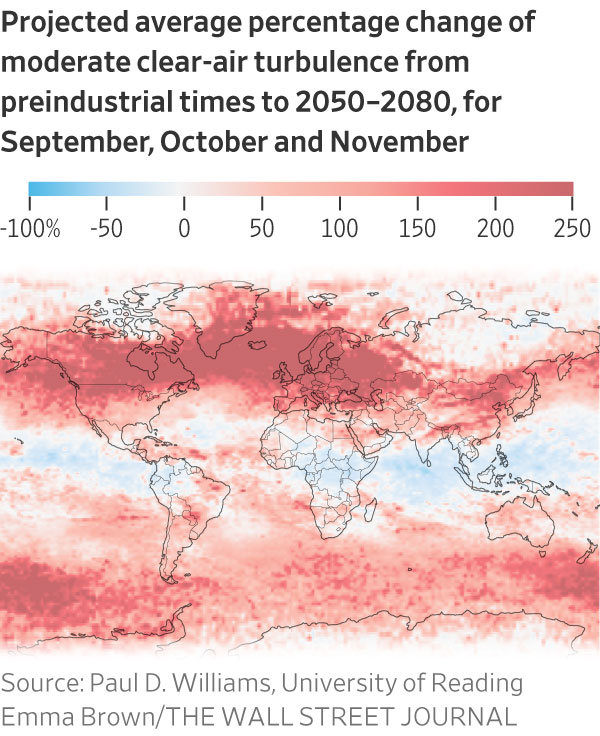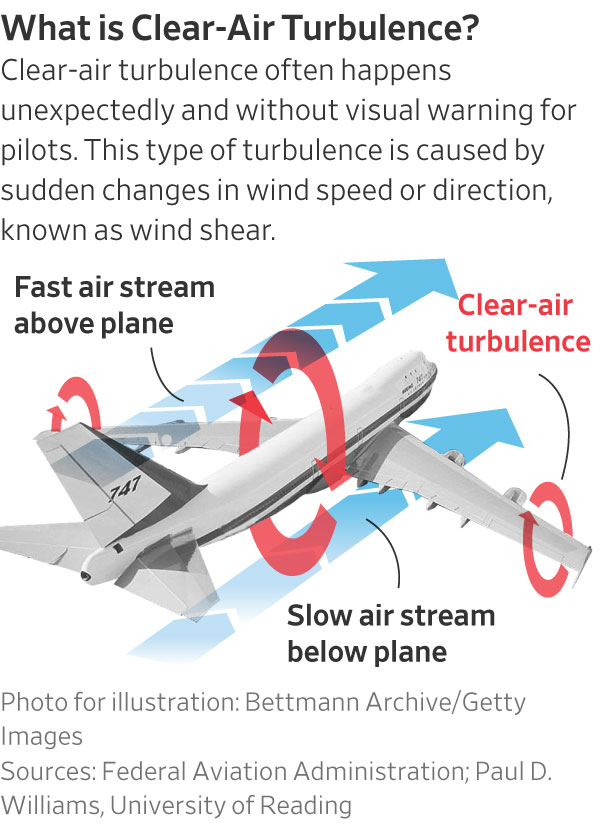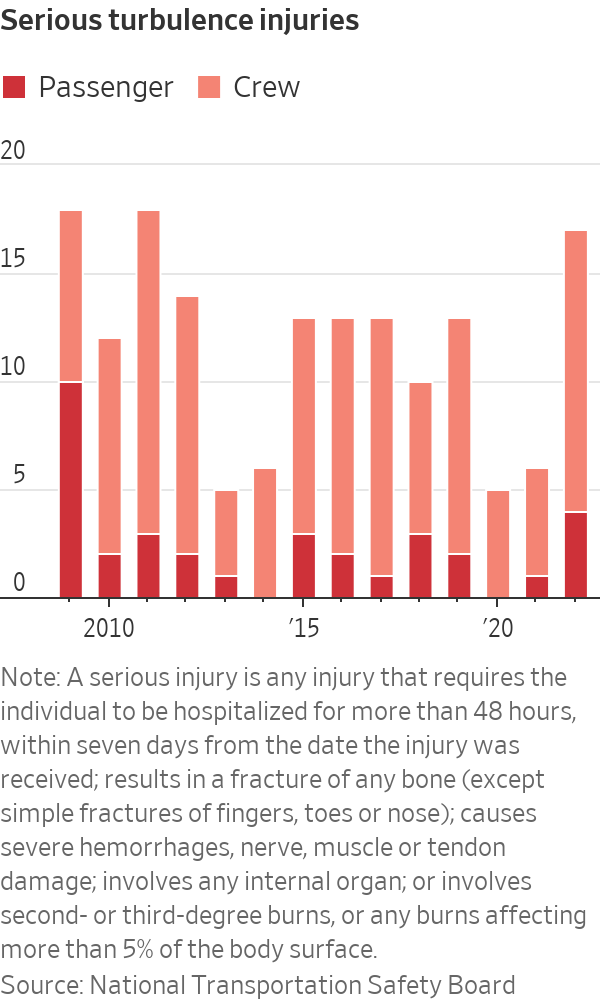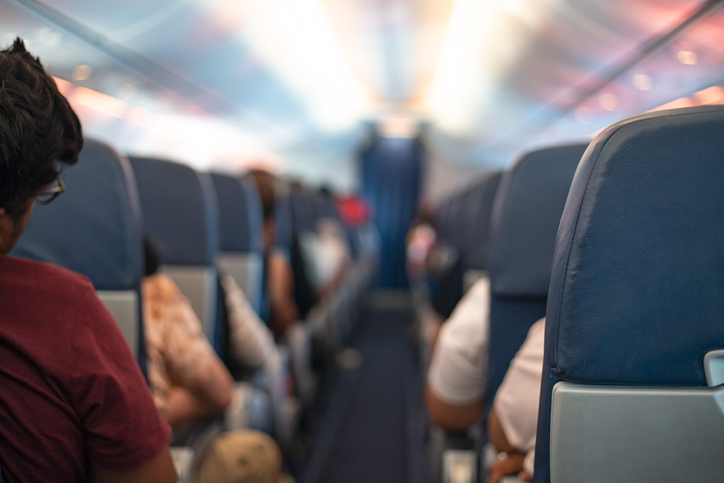Heavy Turbulence on Flights Is Likely to Get Worse
Meteorologists predict more bumpy flights as climate change makes hard-to-detect clear-air turbulence more common
Flights headed to Honolulu, Tampa, Fla., and Frankfurt in recent months hit turbulence so severe that some passengers and crew ended up in the hospital with injuries.
Actor Matthew McConaughey was a passenger on the Lufthansa flight to Germany. In a recent podcast interview with Kelly Ripa, he described seeing red wine suspended in midair before it crashed down.
“It was a hell of a scare,” Mr. McConaughey, who wasn’t hospitalised, said on the podcast. “A complete loss of control.”
Pilots and meteorologists say bumps are a normal part of flying. The Federal Aviation Administration is still investigating the Lufthansa flight. But meteorologists say climate change is distorting the jet stream, making a certain type of severe turbulence—called clear-air turbulence—more likely in the future.
Severe turbulence injuries are rare. Between 2009 and 2022, 163 people were seriously injured during turbulence, according to National Transportation Safety Board data. Flight attendants, who are more likely to be standing during flights, are most likely to get injured, the data show.
What the science says
Though technology that reports turbulence has vastly improved in recent decades, it can be tough to predict.
“You’re talking about a little pin drop in the atmosphere,” says Bill Duncan, head of aviation forecasting operations at the Weather Co., which supplies turbulence forecasts and weather insights to major airlines.
Turbulence happens when swirling air currents push against the wing of the plane, which then moves the wings up and down or the body of the plane from side to side, says Paul D. Williams, a professor of atmospheric science at the University of Reading in England.

Atmospheric pressure, changing wind direction, air around mountains and cold- or warm-weather fronts can cause turbulence, physicists say.
Turbulence caused by wind shear, meaning sudden changes in the speed and direction of wind, is called clear-air turbulence. It is called this because it occurs at higher altitudes in cloudless areas. Aircraft can change altitude suddenly, and pilots usually can’t detect this type of turbulence in advance.
Since 1979, the amount of wind shear in the jet stream has increased 15%, according to a study Dr. Williams co-wrote that was published in the science journal Nature in 2019. At higher altitudes where planes fly, climate change is altering temperature patterns, which creates more wind shear, he says.

Dr. Williams’s research predicts that the amount of clear-air turbulence in the atmosphere in the mid-Northern Hemisphere is expected to more than double over the next three to six decades.
Some of the more popular international flight routes from the U.S., such as New York-London and San Francisco-Tokyo, will experience more clear-air turbulence because they fly in the mid-Northern Hemisphere, he says.
Changes in procedure
Flight crews now use more specific language to address different levels of turbulence, says Dennis Tajer, a captain for American Airlines and spokesman for the Allied Pilots Association, a union. He began flying for commercial airlines about 30 years ago and says he encounters more clear-air turbulence now compared with early in his career.

American Airlines updated its flight manual in May 2022 to better define turbulence procedures for flight crews. The captain turns on the seat belt sign for all types of turbulence, but crews now take specific actions depending on the severity of the turbulence, he says.
During severe turbulence, flight attendants need to secure carts, place hot liquids in carts or on the floor and secure themselves as quickly as possible by sitting down in the nearest seat or on the floor.
American and United are among the airlines that give pilots access to software called SkyPath, which crowdsources turbulence reports from pilots’ iPads in real time.
SkyPath uses vibrations from the pilot’s iPad to measure turbulence and reports out to other nearby aircraft, providing advance warning of the conditions in real time, a United spokeswoman said in an email.
Tips for navigating turbulence
- Wear your seat belt. Staying strapped in is the best way to protect yourself if your flight hits unexpected turbulence, pilots and flight attendants say.
- Take precautions with children under 2. The FAA recommends passengers use an approved child-safety seat or device if traveling with a child under 2. Airlines don’t require children that young to have their own seats. Sara Nelson, the international president of the Association of Flight Attendants-CWA, and the union have renewed calls for all passengers to have their own seats.
- Secure your electronics and other hand-held devices. Anything that isn’t tied down can become a projectile, Ms. Nelson says.
- Remember the odds. Turbulence is scary because it is often unexpected and uncomfortable, says Todd Farchione, a clinical psychologist at Boston University’s Center for Anxiety and Related Disorders. Take a deep breath and realise you’re not truly in danger. Planes are built to withstand even heavy turbulence, pilots and physicists say.
 Copyright 2020, Dow Jones & Company, Inc. All Rights Reserved Worldwide. LEARN MORE
Copyright 2020, Dow Jones & Company, Inc. All Rights Reserved Worldwide. LEARN MORE
Pure Amazon has begun journeys deep into Peru’s Pacaya-Samiria National Reserve, combining contemporary design, Indigenous craftsmanship and intimate wildlife encounters in one of the richest ecosystems on Earth.
Australia’s housing market defies forecasts as prices surge past pandemic-era benchmarks.
The 73-year-old star of ‘Wicked: For Good’ gets cameras flashing with his kooky off-screen style. Here, he discusses his morning stretch routine, a work-in-progress sock drawer and his antagonism toward fitness rings.
From a young age, Jeff Goldblum had an eye for clothes. Growing up in Pittsburgh, he wanted glasses like John Lennon’s and turtlenecks like the Rat Pack’s.
As a member of New York’s Neighborhood Playhouse studying under the legendary Sanford Meisner, he scoured vintage shops for Russian-style overcoats and aviator hats.
After his success in blockbusters like “Jurassic Park” and “Independence Day,” he went through a Japanese-denim phase and loved what he calls “I’ve-been-working-on-the-railroad-type vests.”
“I’ve swung wildly, and I’ve had a lot of bad ideas,” Goldblum said of his style on a recent Zoom.
The 73-year-old wore a bespoke green shirt from Anto, a shirtmaker based near his Los Angeles home.
On his feet were light-green socks, and handmade shoes from Florence, where he lives part-time with his wife, Emilie Livingston, and their two sons.
This month, he reprises his role as the Wizard of Oz in “Wicked: For Good,” the second installment of the film adaptation of the musical juggernaut. He insisted he’s not contracted by Universal Studios to only wear green on the press tour.
In the last decade the world has paid more attention to the actor’s off-screen style, which has evolved since he began working with stylist Andrew Vottero around 2014.
A silver-haired fixture on best-dressed lists, Goldblum often finishes his zany outfits with chunky black specs. He has collaborated with glasses label Jacques Marie Mage and formed a close relationship with Prada , walking its runway and appearing in a 2022 brand campaign.
Here, Goldblum, who regularly performs with his jazz band the Mildred Snitzer Orchestra, talks cashmere, vegan Bolognese and handshakes.
Studying with Sandy Meisner was: a portal into my more-intense interest in clothing. Everything could be a key to finding a character, behavior and discovering who you are in the story – (for example) how the shoe felt and how it made you walk.
You don’t really see: a 1970s-style long shirt collar in stores. I had this green shirt I’m wearing made at Anto in Los Angeles. I have them in a bunch of flavors, including some with Western buttons. I’m thinking about getting one in orange.
I just read: James Kaplan’s two-part biography of Frank Sinatra, whose favorite colour was orange. I’ve always liked orange.
I like: that Marie Kondo book “Tidying Up.” In my youth, my family left me alone one day in the garage. It seemed messy to me. I started to throw everything away. I was sweating under my arms with excitement. I got a big kick out of it.
My kids: like to wear my band merchandise. They sometimes help me dress. I say, “Hey, pick out what I’m going to wear.”
I’ve had to get cozy with one or two: leather jackets for parts like Ian Malcolm in “Jurassic Park.” I have a Saint Laurent motorcycle jacket that I wore the other day that’s kind of tight. I like it a lot.
I probably wouldn’t want to wear: real fur. I’ve stopped eating animals except fish. It’s part health-wise from my nutritionist and part my own feeling about it.
My favourite meal is at: Craig’s in West Hollywood. My wife and I share a chopped salad, minus the cheese, to start. They have a spaghetti squash primavera with broccoli and a spicy tomato sauce. I get it with shrimp or vegan Bolognese.
I’ve always been hypersensitive to: certain fabrics, such as wool. I’ve recently accepted—what’s that wool called?—cashmere. I don’t like things that itch. And I don’t like tags in the back of my shirt. I use a professional seam ripper to cut out tags.
What drives me crazy are: printing machines and my phone, especially how it breaks down so often. I had to deal with that this morning.
My feet must be: comfy cozy. My wife, a ballet dancer, says we’re not really working unless our feet are bleeding. I can’t accept that. I really like these handmade shoes I had made in Florence. They’re the most comfortable ever.
Florence is: a jewel box of a city. I’ve found the people delightful and the quality of life great. There are so many artisans. My favourite hat is one I purchased at the Borsalino store. I don’t know any Italian. Just a word here or there.
I don’t want to get sick so I prefer: fist bumping to a handshake. My knuckles have hurt from a too-hard fist bump. So let’s fist bump gently. Let’s just fist touch.
I have to organise my: sock drawer. It’s in the research and development stage. I’m very into socks of one kind or another. I like to experiment with a colour, which is why I have a light green pair on now. For tight shoes, I like (thin) Pantherella socks . I like a shorter sock, too. Sometimes I make it look like it’s falling down.
For a while I had an aesthetic allergy to: cobalt blue. You’d see it on a lady’s blouse sometimes, and I would go, “That hurts! It’s too bright.” But yesterday, after going to the Dodgers game with my kids, I put on a Dodgers blue cobalt sock, and I was very happy. So I’m nothing if not changeable.
I love: pockets. I recently got a minty green chore coat by the Row that I really like. Its flap pockets are deep enough that things aren’t going to fall out. I’d never even heard the term “chore coat.” It carries my wallet, keys, maybe a Kleenex, a lozenge, a little pillbox with an aspirin and some hand sanitizer.
I never used: sunscreen. But my wife has got me using Sarah Chapman sunscreen , sometimes even tinted. I’ll use a Joanna Vargas serum of some kind. I’m not sure what it’s doing, but I put it on at night. I imitate Boris Karloff (in the “Frankenstein” films) and I make a joke with Emilie that I’m going to my laboratory to work on my new longevity theorem.
My acid-reflux man said: “Take care of your vocal cords.” So I’m off caffeine. I’ll have a Ryze mushroom coffee in the morning—a scoop with hot water and oat milk. Sometimes the kids will make me a decaf cappuccino with oat milk and a sprinkling of chocolate powder, and that is too delightful.
For many decades: I’ve been totally on the natch. I’ll have a sip of red wine if Emilie says it’s really fantastic, but I don’t want to get loopy.
I get the usual: seven or eight hours of sleep. I stopped wearing my Oura ring. I’d be in bed for 8 hours and it would go, “No, Jeff, let’s call it 5½ hours that you got.” It used to say, “You’re somewhat ready for the day,” and I’d say, “Go to H-E-Double Hockey Sticks.” I threw the darn thing away. I go with how I feel.
When I wake up: I go through the little vestige of transcendental meditation I learned decades ago. I crack my bones and do this stretching routine that ends with my taking a tennis racket and going through the motion of a backhand, forehand and serve. Then I take a Centrum for Men multivitamin, play my piano and work out in our gym.
Early on I was: a lanky guy. Then I started lifting weights. I wanted to steer some of those roles that were a little nerdy—even those scientist parts—in a cooler direction.
Am I: nerdy or cool? Well, these days, according to some circles, the two have overlapped. At this point, who knows?
A divide has opened in the tech job market between those with artificial-intelligence skills and everyone else.
When the Writers Festival was called off and the skies refused to clear, one weekend away turned into a rare lesson in slowing down, ice baths included.






















